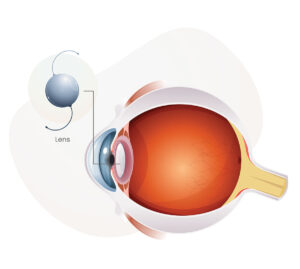What Is Refractive Lens Exchange (RLE)?
Refractive lens exchange (RLE) is indicated if you have presbyopia usually combined with nearsightedness or farsightedness with or without astigmatism, and you desire to reduce or eliminate your dependence on glasses. Presbyopia cannot be corrected simultaneously in both eyes with LASIK.
Why Choose Refractive Lens Exchange?
This procedure is identical to cataract surgery except that the natural crystalline lens of your eye is replaced with a Multifocal Lens Implant or an Accommodative Lens Implant before it becomes cloudy due to a cataract. It is also indicated if you are not a good candidate for LASIK due to dry eye, a thin cornea or other corneal problems. In this case, you would no longer need to be concerned about ever going through cataract surgery for the rest of your life. This procedure has been approved for many years and has a very high success rate. Sometimes both Laser Cataract Surgery and RLE have to be combined to achieve the optimal result. Dr George Khouri is highly skilled in both cataract surgery and laser cataract surgery. Using the combination of these two skill sets, he can maximize your visual outcome by reducing or eliminating your dependence on glasses for far and near and everywhere in between.
Candidates for Refractive Lens Exchange
 You might be a good fit for refractive lens exchange (RLE) if you are tired of reading glasses or contact lenses. The ideal patient for clear lens exchange or lens replacement surgery is over 40. This is the average age for presbyopia, which causes the eye’s natural lens to harden, making it difficult to adjust to see nearby objects clearly. Refractive lens exchange is the perfect procedure for presbyopic patients because LASIK and other refractive surgeries focus on the cornea and can’t address changes to the internal lens.
You might be a good fit for refractive lens exchange (RLE) if you are tired of reading glasses or contact lenses. The ideal patient for clear lens exchange or lens replacement surgery is over 40. This is the average age for presbyopia, which causes the eye’s natural lens to harden, making it difficult to adjust to see nearby objects clearly. Refractive lens exchange is the perfect procedure for presbyopic patients because LASIK and other refractive surgeries focus on the cornea and can’t address changes to the internal lens.
Candidates may have thin corneas and high refractive errors, making them ineligible for laser vision correction. RLE can correct extreme nearsightedness, farsightedness, astigmatism, and presbyopia. However, you must have healthy eyes free from corneal disease and other eye diseases, such as age-related macular degeneration, diabetic retinopathy, and glaucoma. Patients with early cataracts may have RLE because the procedure follows the same steps as cataract surgery.
Benefits of Refractive Lens Exchange
Lens replacement surgery offers crisp, clear vision without corrective eyewear and treats a wide range of refractive errors. Some of the numerous benefits of refractive lens exchange include:
- There is no risk of cataracts later in life because the natural lens which usually becomes a cataract with aging, is replaced with an IOL.
- RLE provides permanent vision correction.
- The IOL requires no maintenance.
- Clear lens exchange involves a short recovery.
- Most patients will not need glasses or contact lenses after RLE.
- People who do not qualify for LASIK may achieve better vision with RLE.
- Lens replacement surgery does not affect corneal thickness like LASIK.
Refractive Lens Exchange Procedure
Clear lens exchange is identical to cataract surgery. It starts with numbing eye drops, and Dr. Khouri may provide medication to help you relax. You are awake during the procedure but will have blurry vision and may see movements around you. Do not apply makeup or face cream on the morning of your surgery.
 Dr. Khouri will use a laser or blade to create a tiny incision where the cornea and sclera come together. The cornea is the clear dome at the front of the eye, and the sclera is the white portion of the eye. Dr. Khouri will make another incision in the lens capsule that houses your natural eye lens.This incision is made either with the laser or with an instrument manually.
Dr. Khouri will use a laser or blade to create a tiny incision where the cornea and sclera come together. The cornea is the clear dome at the front of the eye, and the sclera is the white portion of the eye. Dr. Khouri will make another incision in the lens capsule that houses your natural eye lens.This incision is made either with the laser or with an instrument manually.
The natural lens is broken up into 4 quadrants for easier removal with either the femtosecond laser or a pen-shaped tool through a process called phacoemulsification. The quadrants are then suctioned out with the ultrasound waves of the phacoemulsification instrument anda vacuum-like instrument. Dr. Khouri then inserts your chosen IOL to replace the natural lens through the same incision. The IOL is unfolded and positioned in the lens capsule. Sutures are unnecessary as the corneal incisions are shelved so they will be sealed when the eye is repressurized with saline solution at the end of surgery allowing the eye to heal itself. A protective eye shield is necessary to protect your eyes during recovery for the first 24 hours and only while sleeping the following 6 nights after surgery.
Refractive lens exchange usually takes less than 30 minutes and boasts a 95% patient satisfaction rate.
Recovery After Refractive Lens Exchange
Our team at Palm Beach Eye Center will give you post-op instructions for RLE recovery. You may experience temporary side effects after clear lens exchange, such as gritty sensations, watery eyes, and eye redness. Your eyesight should clear up a few days after RLE, but you will need someone to drive you home on the day of your procedure and possibly help you get to your follow-up appointment the next day.
Most people can usually drive the day after the refractive lens exchange. Prescription eye drops will help your eyes heal, and it may take up to four weeks for full recovery.
Most patients can return to work and their regular routine the day following RLE depending on the amount of preoperative eyeglass prescription. Dr. Khouri will outline your recovery timeline and discuss when it’s okay to drive, return to work, swim, and exercise. Make sure you attend all follow-up appointments and contact our West Palm Beach office with any questions or concerns during refractive lens recovery.
To find out if this procedure would be indicated for you, contact us today to schedule your appointment with Dr Khouri.









